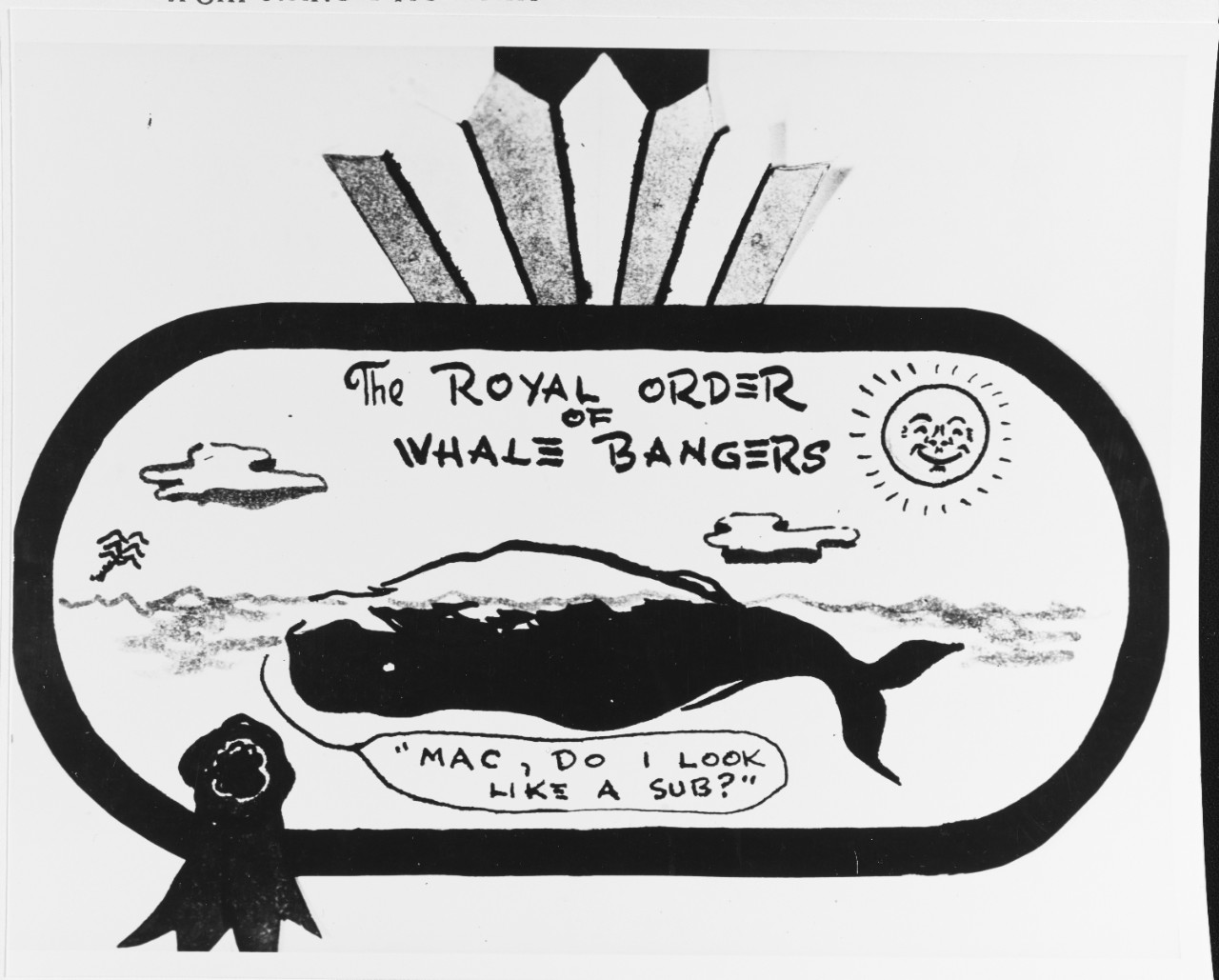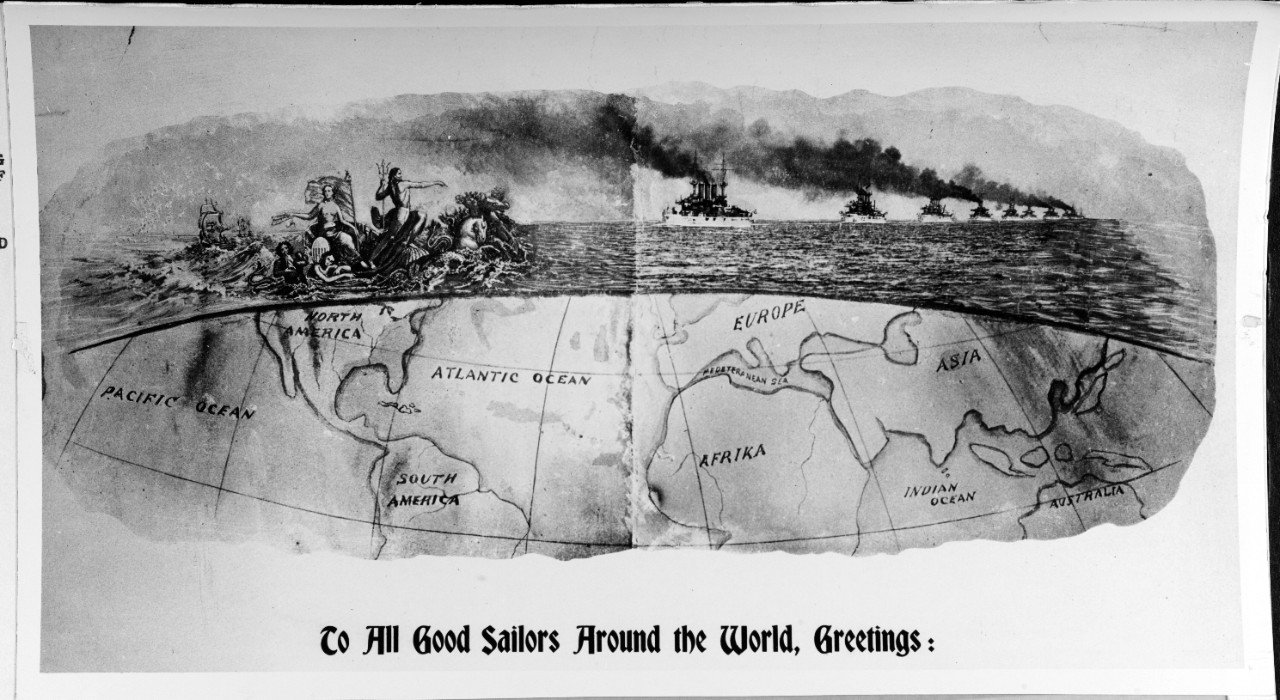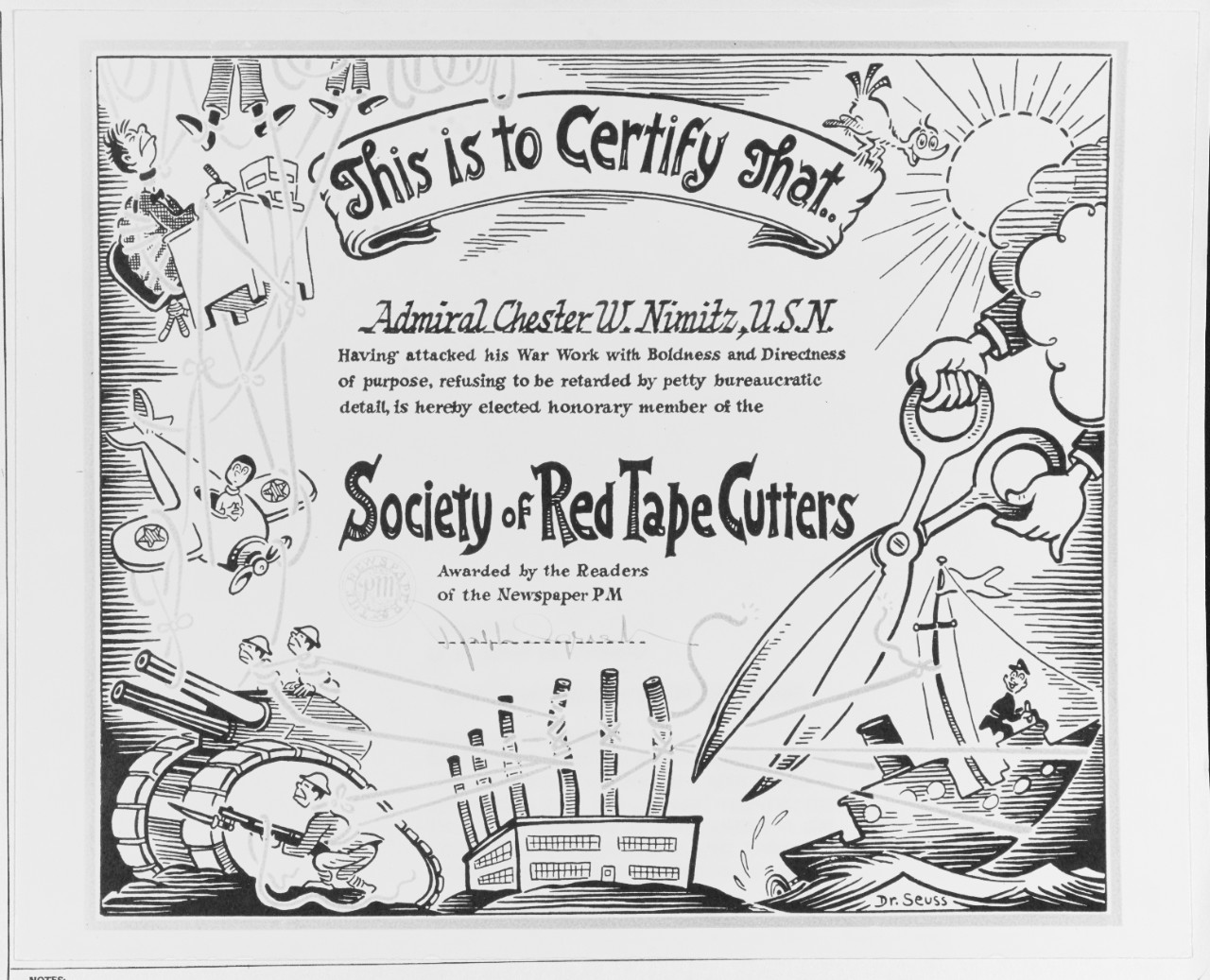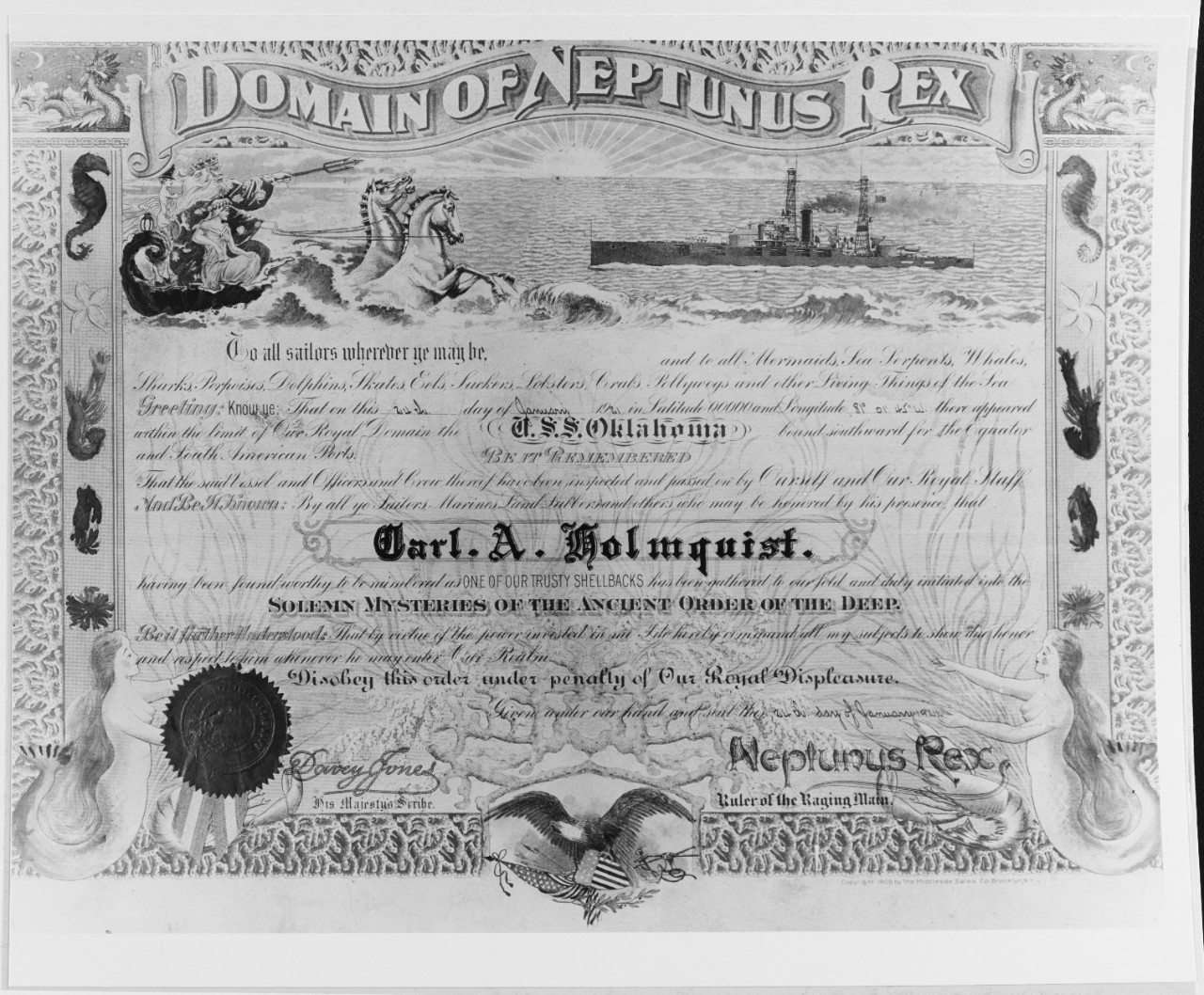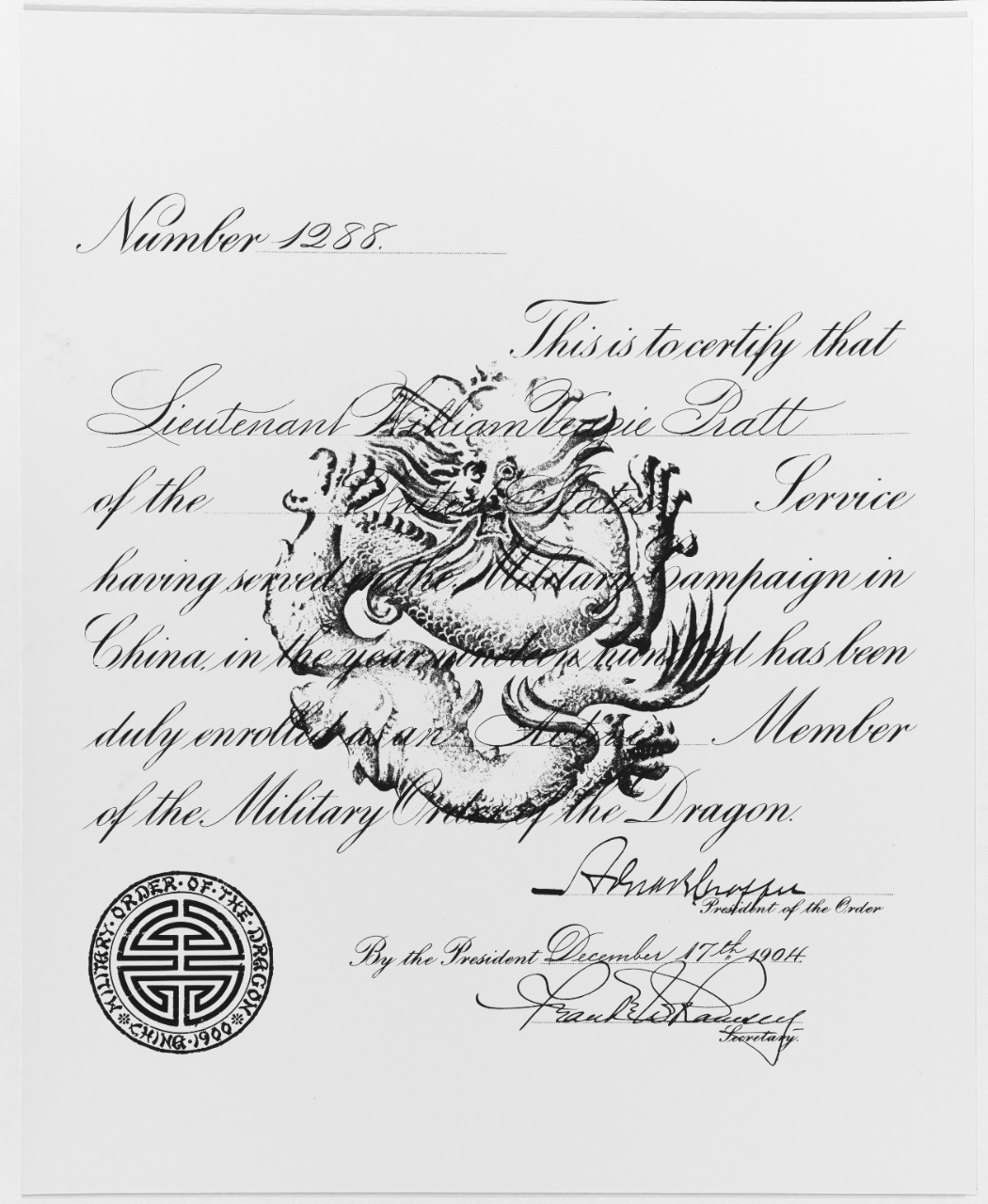Unofficial Navy Certificates
Crossing the Line, Plank Owner, and Other Unofficial Certificates Acquired by Naval Personnel
Adapted from: Silvey, Frank. "The Certified Sailor." All Hands 633 (Oct. 1969): 16-21.
There are serious ones, humorous ones, and unusual ones. But any Sailor worth their salt will never rest until they have a scrapbook full of them.
They are the unofficial certificates that document where a Sailor has been, what they have done, and most importantly, what they are—a Shellback or a Blue Nose or a Mossback or a Double Centurion. Or even a Goldfish or Sea Squatter.
On any noteworthy occasion — and perhaps on some that might be otherwise forgotten — somebody in the crew is sure to spend hours at a drawing board to create a memorable certificate, replete with salty language, drawings of mermaids and tritons and anchors and chains, and the signature of Neptunus Rex or some other high potentate, and forever after the crew of that ship will treasure their copies as they treasure their rating badges.
Nowadays it's all in fun and without official recognition. But mariners of earlier years, when it all began, were in earnest. As all sailors knew well, Neptune, god of the sea, was fickle. He played an important role in ancient rituals just as he does in today's initiations into the Orders of the Deep. At his slightest whim, Neptune, it was believed, might throw a storm into the path of a ship that would splinter her oars and spars like matchwood, or cast her onto the rocky coast.
And that was when he was feeling playful. What would the dreaded deity bring to a crew if, Zeus forbid, they made him angry?
The superstitions of the sea provided for ways to stay out of that kind of trouble. In the earliest days, oxen and goats might be sacrificed to make the Old Man of the Sea more favorably disposed. He could, under proper circumstances, become downright protective and benevolent.
Also, in those early rituals, the location of the rites had to be right. If every element surrounding the ceremonies was not just so, all Hades might break loose. The location of the ship had an effect on how acceptable the honors to Neptune were. A rite performed off certain capes (for instance, those with temples on them) would work best.
And finally, the apprentices had to be instructed in the behavior that was acceptable and unacceptable. As a later Ancient Mariner discovered to his grief, the rulers of the deep frown on anyone who kills an albatross. There were dozens of such strictures — and woe betide the sailor, no matter how green, who transgressed just one.
As previously stated, an ox or a goat was normally sacrificed to appease the sea gods. But not always. Jonah, for example (as our Bible experts recall), was dropped over the side when the crew of the ship on which he was a passenger decided he had brought on the storm that threatened to wreck them. It worked. The storm stopped, Jonah was picked up by a passing whale, and the ship sailed on.
Even as late as the 17th century, when no one (well, hardly no one) believed in Neptune or other marine deities any more, initiation into the mysteries of the deep could be a rough process. According to a writer of the time, apprentices "who pass certain places, where they have never passed," undergo various penalties — for example, to be dropped "from the yardarm into the sea."
Such are the origins of the granddaddy of all seagoing ceremonies: the shellback initiation when a ship crosses the Equator (i.e., “the Line”), in which "Pollywogs" (Sailors who have not previously Crossed the Line) become "Shellbacks" (fit subjects of King Neptune).
The colorful tradition and ceremonious rituals survive, but anything dangerous or demeaning is prohibited by Navy regulations today.
Here's how SecNav [Secretary of the Navy] Instruction 1610.2, dated 1 Oct. 1997 spells out the policy concerning military functions which involve initiations or other similar ceremonies:
Military customs and traditions have long been an integral part of the Navy and Marine Corps. Although in the past some hazing has occurred in conjunction with ceremonies, initiations or rites of passage, these activities, if properly supervised, can be effective leadership tools to instill esprit de corps, unit cohesion and respect for an accomplishment of another Sailor or Marine. While most ceremonies commemorate the many selfless feats of bravery of our military men and women, they also commemorate significant events. These feats and events form the basis upon which our Core Values of Honor, Courage, and Commitment were founded. Graduations, chiefs' initiations, "crossing the line" ceremonies, and others are only meant to celebrate and recognize the achievements of individual Sailors or Marines or those of entire units. Service members must be able to work together, building-up, encouraging, and supporting their shipmates. Hazing behavior that is degrading, embarrassing, or injurious is unprofessional and illegal.
Commanders must be aware of all ceremonies and initiatives conducted within their organizations and take proactive steps to ensure that these activities do not violate this policy.
Hazing is defined as any conduct whereby a military member or members, regardless of service or rank, without proper authority causes another military member or members, regardless of service or rank, to suffer or be exposed to any activity which is cruel, abusive, humiliating, oppressive, demeaning, or harmful. Soliciting or coercing another to perpetuate any such activity is also considered hazing. Hazing need not involve physical contact among or between military members; it can be verbal or psychological in nature. Actual or implied consent to acts of hazing does not eliminate the culpability of the perpetrator.
Hazing can include, but is not limited to, the following: playing abusive or ridiculous tricks; threatening or offering violence or bodily harm to another; striking; branding; taping; tattooing; shaving; greasing; painting; requiring excessive physical exercise beyond what is required to meet standards; "pinning"; "tacking on"; "blood wings"; or forcing or requiring the consumption of food alcohol, drugs, or any other substance.
We won't go into detail on what occurs when Neptune and his court are piped aboard and the Pollywogs join the Order of the Shellbacks, because that's a mystery of the deep, after all. Suffice it to say, that when the day ends, the Shellback has arrived.
To prove it, he has a certificate of impressive size, festooned with drawings of fish, mermaids, and a trident-wielding Neptune, which proclaims in effect:
TO ALL SAILORS WHEREVER YE MAY BE and to all Mermaids, Sea Serpents, Whales, Sharks, Dolphins, Skates, Suckers, Lobsters, Crabs, and other Living Things of the Sea, GREETINGS:
KNOW YE: That on this ......., day of .......... 19...... in Latitude 000º 00' and Longitude ...................., there appeared within Our Royal Domain the ...................., bound for .................... .
BE IT REMEMBERED: That said Vessel, Officers and Crew thereof having been inspected and passed on by Yourself and Our Royal Staff,
AND BE IT KNOWN: By all ye Sailors, Mariners and Land Lubbers, who may be honored by his presence, that
Seaman W, T. Door, USN, having been found worthy to be numbered as ONE OF OUR TRUSTY SHELLBACKS, has been gathered to our fold and duly initiated into the SOLEMN MYSTERIES OF THE ANCIENT ORDER OF THE DEEP.
BE IT FURTHER UNDERSTOOD: That by virtue of the power invested in me I hereby command my subject to show due honor and respect to him whenever he may enter Our Realm.
DISOBEY THIS ORDER UNDER PENALTY OF OUR ROYAL DISPLEASURE.
Neptunus Rex
Ruler of the Raging Main
Or something of a similar nature.
Obviously, the Sailor who isn't so certified is little more than a land lubber. Ask any shellback. The Pollywog simply hasn't been around — and a worse stigma for a Sailor is hard to imagine.
Through the years, the wish to mark other seagoing milestones has given birth to certificates for all kinds of distinctions. Most of them are what the television industry would call "spin-offs" — imitations with variations from the Shellback idea; they document, in salty language, passing certain places for the first time. The Domain of the Golden Dragon, for instance. You enter the dragon's empire when you cross the International Date Line by sailing west (say some), or sailing east (say others). With the extensive Navy operations in the Far East since (and before) World War II, this passage has become so common that few initiation ceremonies are actually held. But the certificate, decorated with Chinese-style dragon, will still find its way to a place on the wall of a Sailor's den.
Other notable line-crossings have their certificates too. For the intrepid Sailor who crosses the Arctic Circle, various documents will attest his entrance to the Northern Domain of the Polar Bear or the Royal Order of the Blue Noses.
The Arctic Circle certificates have a long seafaring tradition behind them. In the Middle Ages, when European sailors almost never got to the Equator, they held ceremonies similar to the shellback initiation on crossing the Arctic Circle or entering the tropics. Nowadays, King Polar Bear is piped aboard at the limit of his domain, and lets his wrath be known to the "Red Noses" — the uninitiated.
At the other end of the world, you enter the Royal Domain of the Emperor Penguin by crossing the Antarctic Circle, and His Imperial Majesty inducts you as a Frozen Stiff. The bearer of this certificate is entitled "to all of the privileges of this frozen realm of blizzards, including freezing, shivering, starving, and any other privileged miseries that can possibly be extended during his stay in this land of answer to a well digger's dream."
And while you're in southern latitudes, you might qualify for a distinction that has become rare in this age of the Panama Canal: the title of Mossback. Members of this exclusive brotherhood are those who have completed the fearsome voyage around stormy Cape Horn. They are given the right to spit into the wind, if they want to risk it.
But even if you were a Shellback, Mossback, Blue Nose, Frozen Stiff, and subject of the Golden Dragon, there would be more distinctions you could gain. Sailors' ingenuity has given rise to several combinations of these awards — based on a ship's achieving more than one on the same voyage, or even at the same time.
For instance, those who cross the 180-degree Prime Meridian and the Equator at the same time become Golden Shellbacks. And in 1965, the submarine USS Capitaine (AGSS-336) topped nearly everybody by crossing the intersection of the two lines underwater.
Or, if you round the Horn and cross the Equator on the same voyage, you are duly honored as a Horned Shellback. Of course, it's hard for a Mossback to avoid becoming a Shellback,sothis certificate is rare.
And it's a safe bet that some ships have made out Blue-Nose-Shellback cards or Frozen-Mossback certificates. We just haven't seen them yet.
Of course, certificates are available for round-the-world voyages and similar out-of-the-ordinary cruises. We suspect that some special certificate is made for achievements such as that of USS Edisto (AGB-2) in 1955. In that one year, her crew became Blue-Nosed, Frozen-Stiff, Golden-Dragon Shellbacks. That's hard to top.
Many such certificates are invented to commemorate participation in a specific operation. Random examples include the West of Shanghai-Manila Club, comprising men who were in the first task group to enter the Sulu Sea after the fall of the Philippines during World War II, and the Royal Order of the High-jump, for participants in the Antarctic operation of that name in 1946-47.
But you don't have to cross a line or round a cape to receive a certificate.
You may be a Plank Owner if you were a member of the commissioning crew of a ship and served aboard for a year, a month, and a day after commissioning. (Some ships waive the service requirement. It's all unofficial, after all.)
According to tradition, a member of a ship's commissioning detail in the days of wooden vessels had the right to take a plank from her deck when she was decommissioned. It made a good conversation piece for his mantel. Today, it would be difficult to find a plank on a steel ship; but crew members cherish the certificate that gives them "clear and unencumbered title" to one anyway.
Different units have made their own variations. A helicopter squadron made its original crew "Rotor Rooters," giving them title to one rotor blade. Another variant is the "Plank Preserver" certificate given to members of the decommissioning crew of USS Monongahela (TAO-42).
Whether or not you helped commission or decommission a ship, if you served aboard one a long time you may be eligible for another honor: the status of Shackle and Grommet Owner. The rules for this distinction, as for all unofficial awards, vary among ships; some require 15 years, some say three consecutive enlistments. (A shackle, by the way, is a U-shaped steel connection with a pin through the open end, used to make things fast. A grommet is a metal eyelet in a piece of canvas. But all you Shackle and Grommet Owners know that already.)
Milestones in a Sailor's career often rate notice in the form of certificates. Pilots join the "Century Club" when they make their hundredth carrier landing, then become "Double Centurions" at 200. Some pilots over Vietnam were inducted into the "200 Mission Club" and the "300 Mission Club." This tradition has continued in subsequent conflicts.
Another "Century Club" is an organization of Florida-based hurricane hunters who have flown through winds of 100 miles per hour or more. Members of the "Not So Ancient Order of the Hurriphooners" receive a scroll bearing the legend: "At wave-level height, this member has battled forces of Neptunus Rex and aerial elements of the Chief High Gremlin to a standstill." It is signed by the Most Exalted Hurriphoon Hunter and the High Hurriphoon Cloud Sniffer.
But not all certificates are for achievements such as flying an aircraft through a hurricane. The same viewpoint that invents new horrors for Pollywogs also devises a suitable award for that occasion when a man makes a fool of himself.
At one squadron "awards ceremony," a red-faced aviator was, with due pomp, given a citation as an ace Tire-Buster — for blowing a tire on each of a half-dozen landings.
And then there was the carrier's print shop that printed the daily air plan in red ink, instead of black, by mistake. Under the red lights in Air Ops and elsewhere, the red air plan looked like a blank sheet of paper. The print shop was duly honored with a certificate for unoutstanding performance — along with comments by the Air Ops crew that can't be reproduced here.
To qualify for membership in the Royal Order of Whale Bangers, you must have been onboard a ship when she fired at a whale, mistaking it for a submarine.
But among the less-than-glorious clubs are some that Navy personnel are glad to be around to join.
The High-floating Hook-Bouncing Barrier Crashers, for one. It's for carrier pilots who had to use the emergency barrier to land.
Another one is the Goldfish Club, for pilots who ditch and have to take to a life raft. If they spend more than 24 hours on the raft, they become Sea Squatters. (The latter award is open to Blackshoes, too. Any takers?)
And among the most grateful recipients of dubious honors are the members of the Caterpillar Club — comprising anyone who has made an unscheduled parachute jump from a disabled plane. In memory of their use of the silkworm's product (or nylon, as the case may be), club members wear a gold caterpillar pin — on civvies only, of course. The color of the caterpillar's jeweled eyes is determined by the circumstances of the jump; for instance, ruby eyes show that the wearer has survived a midair collision.
Pilots in the Korean Warwere given cards certifying their membership in the "Railroader's Union." Members had the privilege of working on North Korean railroads as "Journeyman Railcutters."
The process of inventing new certificates never ends. Documents for future operating areas are being prepared.
The moon, for instance. Any Seabee chosen for the first Navy Construction Team lunar expedition will likely receive an honorary Moon Construction Team card.
But the most exclusive certificate of the century has already been issued: the plaque taken to the moon by former naval aviator, Neil Armstrong, and his Apollo 11 shipmates. Not even a Golden Blue-Nosed Shellback can match the distinction of being the first men on the moon."
Unofficial Certificates Are Not (Repeat Not) Stocked by the Navy
The Navy History and Heritage Command, Navy Personnel Command, and All Hands magazine do not maintain records of who received the certificates named in this article. These certificates are unofficial; copies were not forwarded for inclusion in the Navy's official personnel or command records. None are in the Navy-wide supply system. A few local commands might design and print such items as the Shellback certificate in their own print shops, but this practice is not common.
Many certificates were originally drawn and lettered by the men who participated in the event — and then all the copies were handed out to the crew. Some of the more common documents — Shellback, Golden Dragon, Arctic, Antarctic, Plank Owner, and others — are sold by commercial firms catering to Navy personnel. However, no certificates are printed or supplied by any government agency above the local command level.
Additional Resources
List of Unofficial U.S. Navy Certificates
Plank Owners, Plank Owner Certificates, and Planking
Selected Imagery (click image to download)

